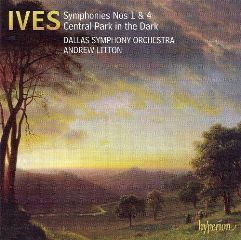Charles Ives - Symphonies Nos 1 & 4 - Central Park in the Dark (2006)
Charles Ives - Symphonies Nos 1 & 4 - Central Park in the Dark (2006)

Symphony No 1 1.Movement 1: Allegro, con molto [11'35] 2.Movement 2: Adagio molto, sostenuto [8'29] 3.Movement 3: Scherzo: Vivace [4'16] 4.Movement 4: Allegro molto [12'50] Symphony No 4 5.Movement 1: Prelude: Maestoso [3'14] 6.Movement 2: Comedy: Allegretto [10'52] 7.Movement 3: Fugue: Andante moderato con moto [8'01] 8.Movement 4: Very slowly: Largo maestoso [8'45] 9.Central Park in the Dark [9'46] Dallas Symphony Chorus (5, 8) Dallas Symphony Orchestra Andrew Litton (conductor)
Special thanks to Thomas Ciannarella who's sent this album to us.
For the Charles Ives enthusiast on the left side of the Atlantic "pond," this Hyperion release, Ives: Symphonies 1 & 4, brings up some red flags upon first appearance. While the movers and shakers in English classical music circles are famously xenophobic, they tend to fault Americans for being equally so, and when an American sees the music of Charles Ives on an English label, that instinctively comes to mind. These are not English performances, though; they were made at McDermott Concert Hall in Dallas and feature the Dallas Symphony Orchestra under the direction of Andrew Litton. That brings up another red flag: Litton has already recorded Ives' Orchestral Set No. 1: Three Places in New England with Dallas for the late Dorian label, and that hardly set the world on fire at the time of release (in 1996). On the other hand, it is not as though record companies are trying to outdo one another recording Ives' symphonies at present, so it might not be a bad idea to give Litton's Ives: Symphonies 1 & 4 a chance. The Dallas Symphony and the music of Ives already have an established history which goes back to at least the 1960s, when conductor Donald Johanos led the DSO in a widely circulated performance of Ives' Holidays Symphony for Vox Turnabout.
The performance of Ives' Symphony No. 1 here is of the highest caliber. Ives regarded it as one of his "weak sisters," a school assignment barely worth discussing, and annotator Jan Swafford, who should know better, sides with the composer in this instance. Nevertheless, Ives' First has a gentle, persuasive power uniquely its own that has hooked some listeners who could care less about Ives' noisy orchestral sets and the Symphony No. 4; Litton manages to tease this persuasiveness carefully out of the Dallas Symphony. Additionally, the score utilized here seems to make little to no use of any of Ives' variant concepts for this work -- not a desirable state of affairs for all of Ives' symphonies, but not a bad idea for this one. Ives: Symphonies 1 & 4 might contain the finest Ives First to appear on record since André Previn's with the London Symphony Orchestra back in 1971. Ironically, Litton's ability to make the Dallas Symphony sound like an English, or at least European, orchestra is one of the things that makes this recording so good; notwithstanding the flag-waving xenophobes out there.
The Symphony No. 4 and Central Park in the Dark, however, are another matter. Litton does make use of the optional chorus in the first movement of the Fourth, and it is nicely done. However, Hyperion's recording is none too friendly to the extremes of volume in this symphony. Litton manages to get very good results out of the quartertone section in the strings that open the second movement "comedy," but it is hard to hear, even when played back at top volume. The same goes for Central Park in the Dark, marked to be played very quietly in the score, but just because you can get that quiet doesn't mean that you should do so on a recording, as loud sections might terminate one's speakers with prejudice. Nonetheless, another aspect of this particular Fourth that may or may not be so desirable is that Litton has shaped it so carefully. The whole work has been marked out to separate foreground elements from the rest, tempering Ives' divine approach to chaos. This may prove a boon to those who can generally make no sense of the Fourth, but for experienced Ivesians, part of the appeal of the Fourth is its wacky and transcendental messiness. Of course, such does not apply to the Fourth's traditional third movement, which comes off quite well here. In general, the rule with Litton's Hyperion traversal through Ives' symphonies seems to be the more stylistically conservative a given Ives symphony is, the better the results. If so, then if you could own only one of the two volumes, this one would not be the more desirable choice. ---Uncle Dave Lewis, AllMusic Review
download (mp3 @ kbs):
yandex 4shared mega mediafire zalivalka cloudmailru uplea ge.tt
